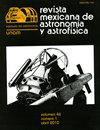超紧h区域的搜索与研究
IF 1.7
4区 物理与天体物理
Q3 ASTRONOMY & ASTROPHYSICS
Revista Mexicana de Astronomia y Astrofisica
Pub Date : 2023-10-01
DOI:10.22201/ia.01851101p.2023.59.02.08
引用次数: 0
摘要
我们给出了用甚大阵列在B和C配置下观测到的106个高亮度IRAS源样本的结果。在x波段观测到96个源,在k波段观测到52个源,其中42个源在两个波长均被观测到。我们还使用了先前发表的14个c波段的观测结果。3.6 cm连续发射源的检出率约为25%,1.3 cm连续发射源的检出率仅为10%。为了研究这些源的性质,我们主要使用3.6 cm连续发射来计算它们的物理参数,对于两个波长的源,我们使用了三种不同几何形状的H区模型的最佳拟合。最后,我们给出了一个探测到的源的目录,其中包括它们的基本物理参数,以供进一步分析。该星表包含17个超紧H区和3个紧H区。本文章由计算机程序翻译,如有差异,请以英文原文为准。
SEARCH AND STUDY OF ULTRACOMPACT H II REGIONS
We present results from a sample of 106 high-luminosity IRAS sources observed with the Very Large Array in the B and C configurations. 96 sources were observed in the X-band and 52 in the K-band, with 42 of them observed at both wavelengths. We also used previously published observations in the C-band for 14 of them. The detection rate of sources with 3.6 cm continuum emission was ≈ 25%, while only 10% have emission at 1.3 cm. In order to investigate the nature of these sources, their physical parameters were calculated mainly using the 3.6 cm continuum emission, and for sources detected at two wavelengths, we used the best fit of three H iiregion models with different geometries. As a final result, we present a catalog of the detected sources, which includes their basic physical parameters for further analysis. The catalog contains 17 ultracompact H II regions and 3 compact H II regions.
求助全文
通过发布文献求助,成功后即可免费获取论文全文。
去求助
来源期刊

Revista Mexicana de Astronomia y Astrofisica
地学天文-天文与天体物理
CiteScore
1.30
自引率
10.00%
发文量
14
审稿时长
>12 weeks
期刊介绍:
The Revista Mexicana de Astronomía y Astrofísica, founded in 1974, publishes original research papers in all branches of astronomy, astrophysics and closely related fields. Two numbers per year are issued and are distributed free of charge to all institutions engaged in the fields covered by the RMxAA.
 求助内容:
求助内容: 应助结果提醒方式:
应助结果提醒方式:


